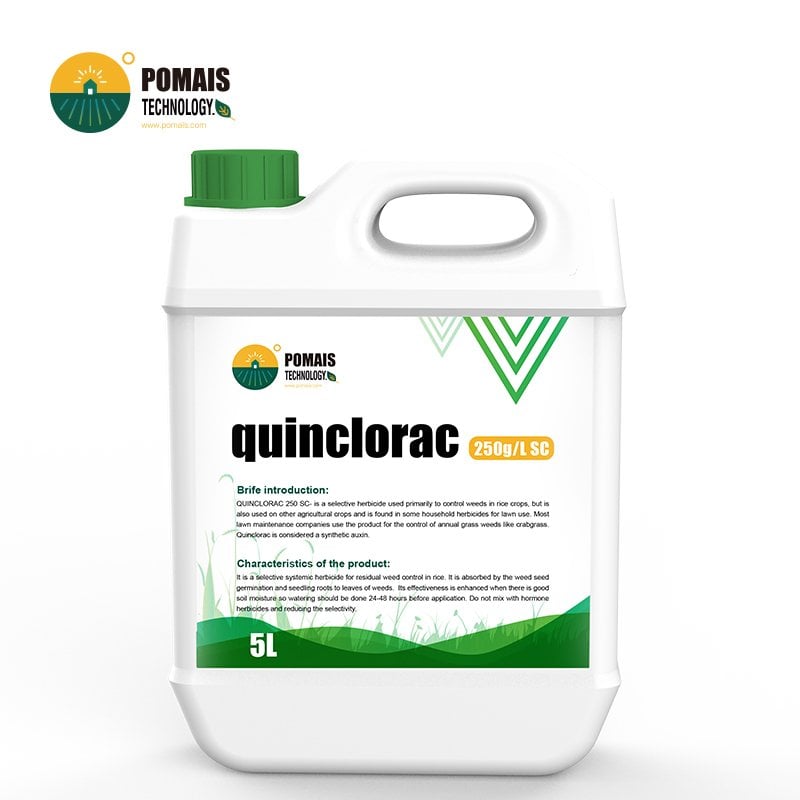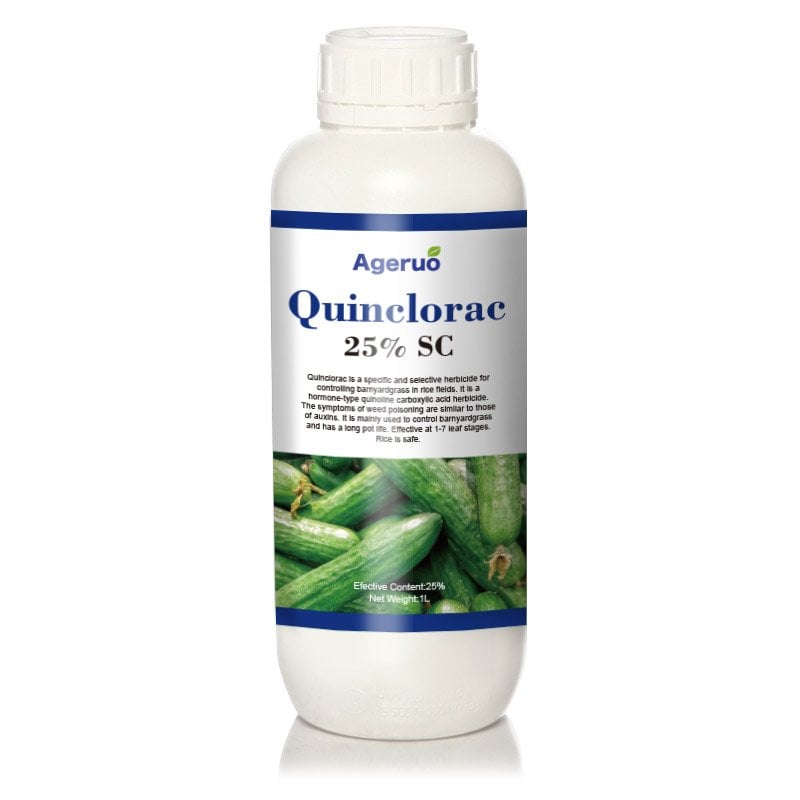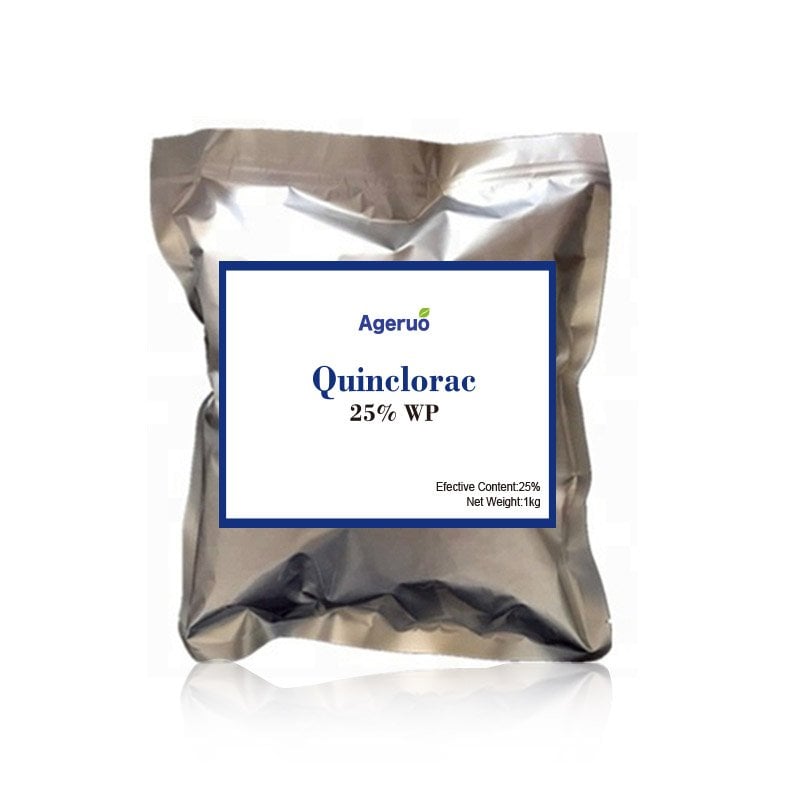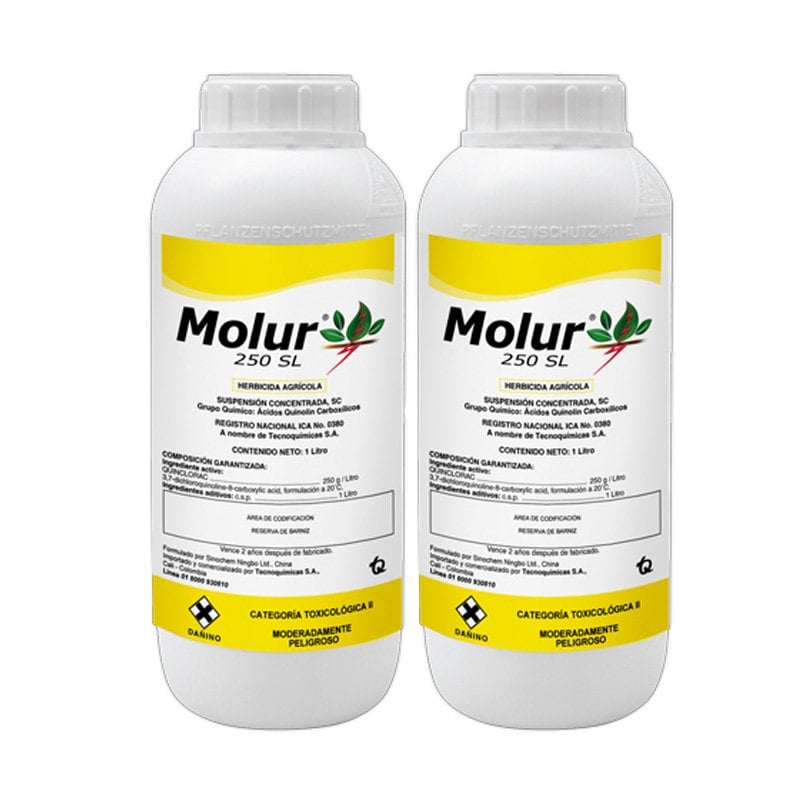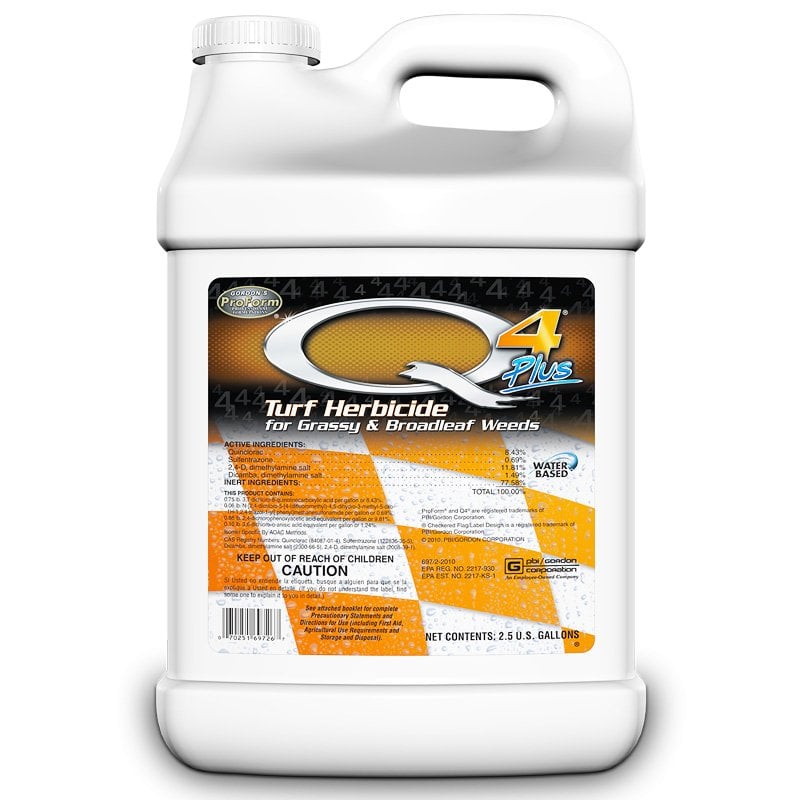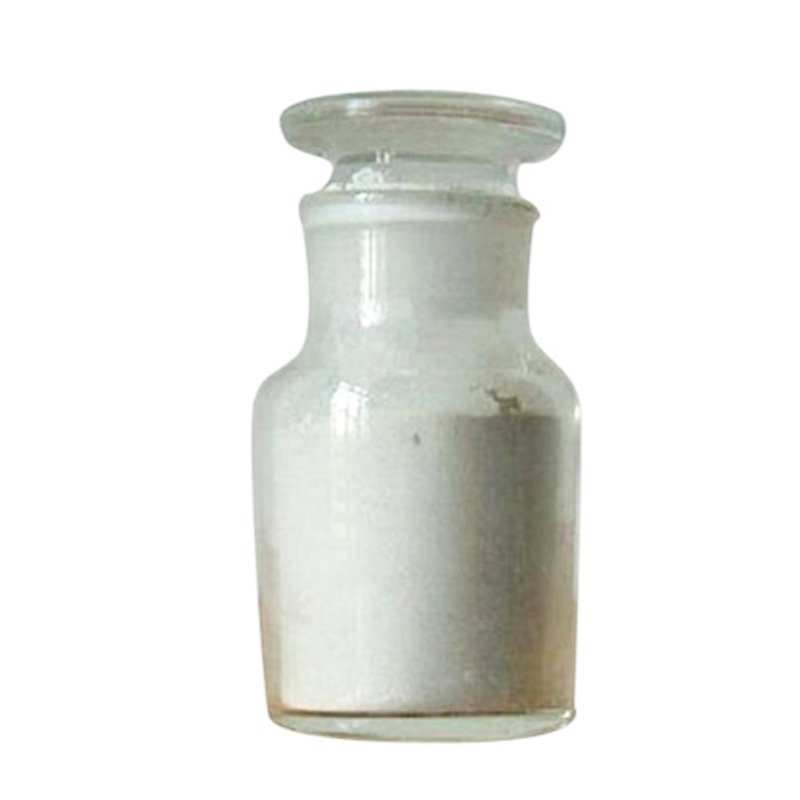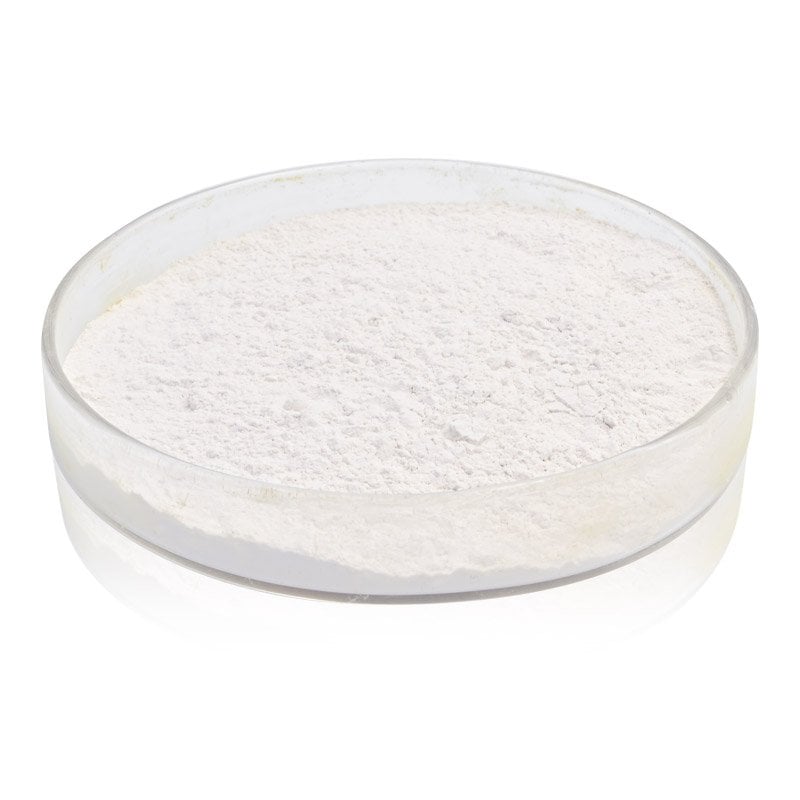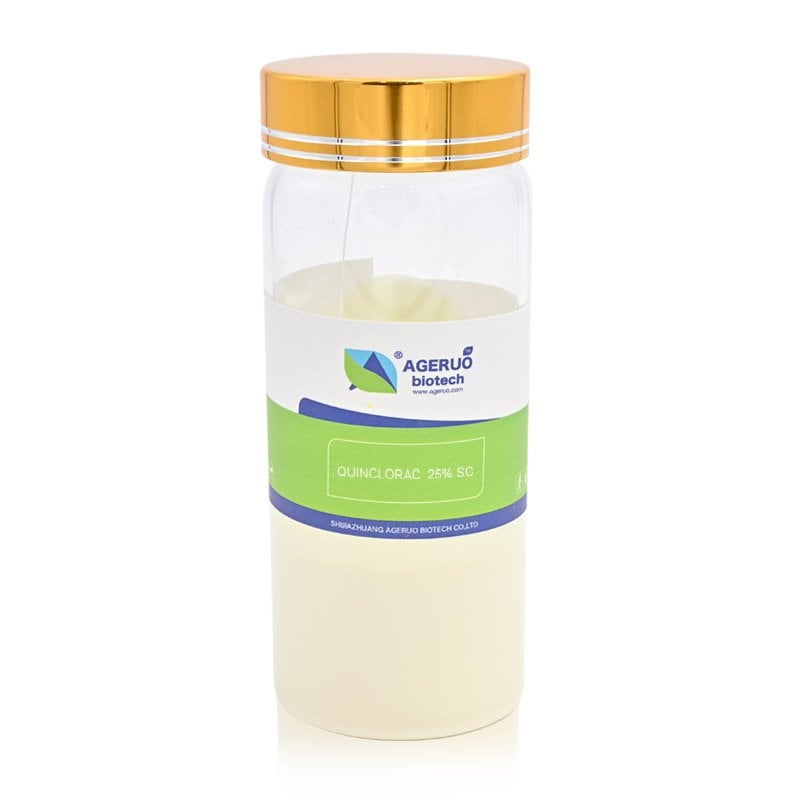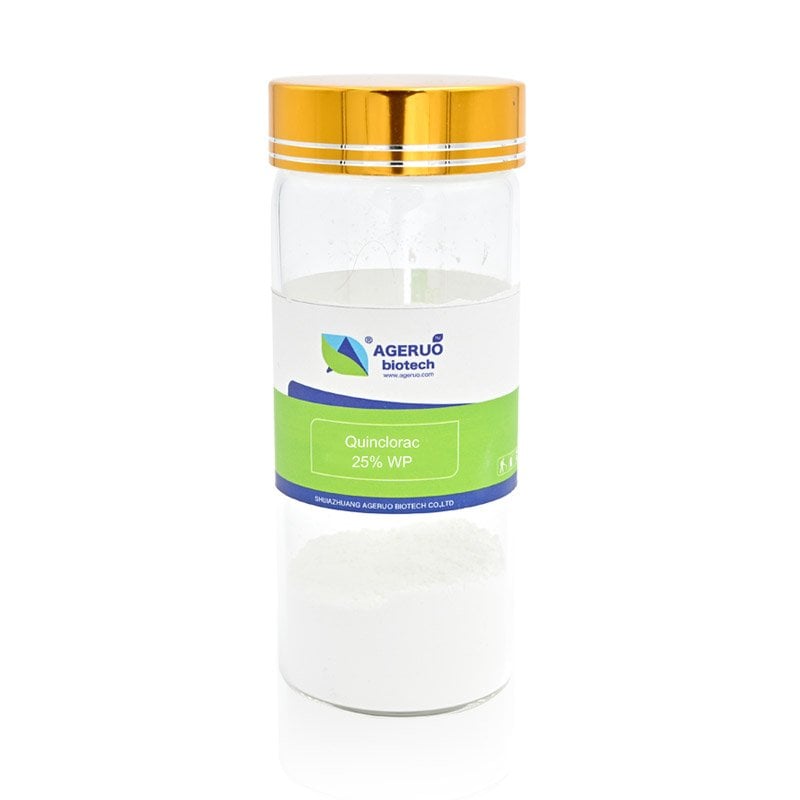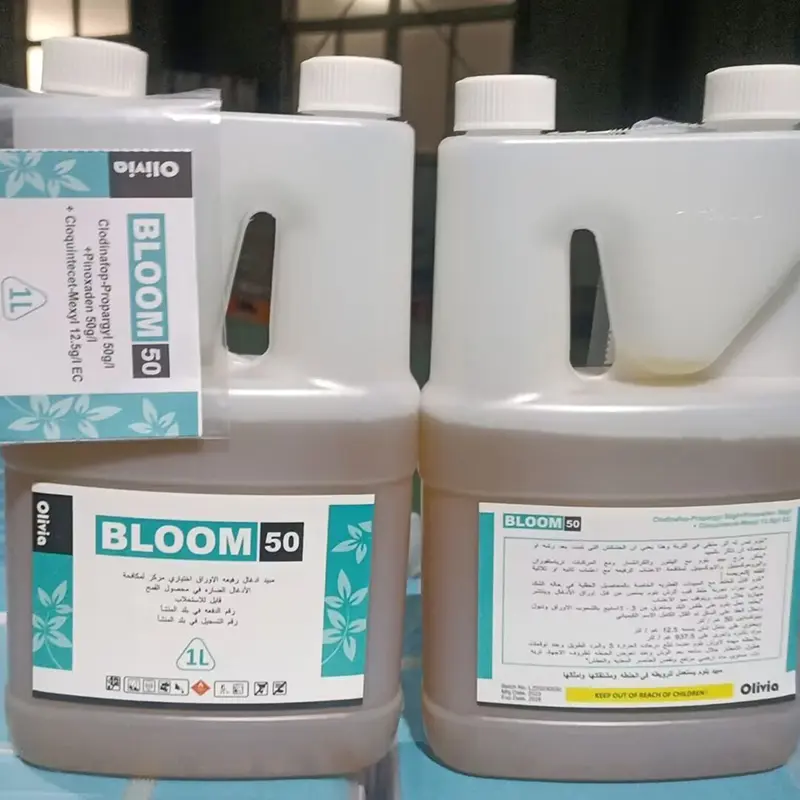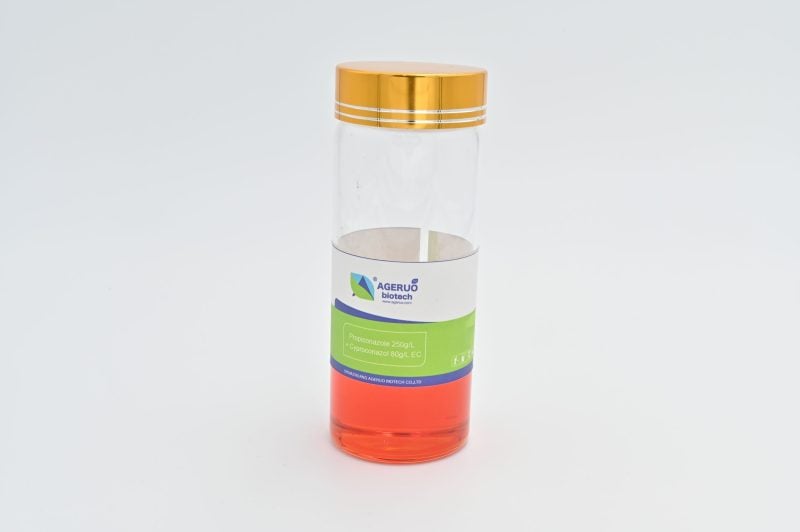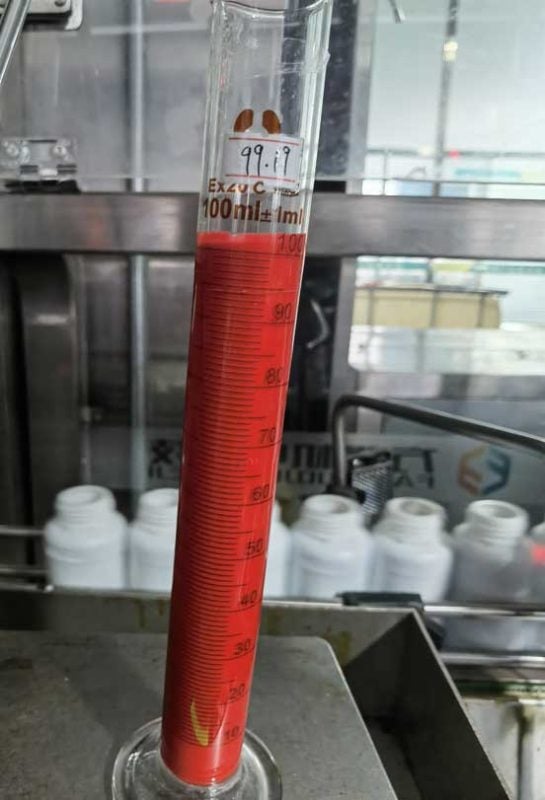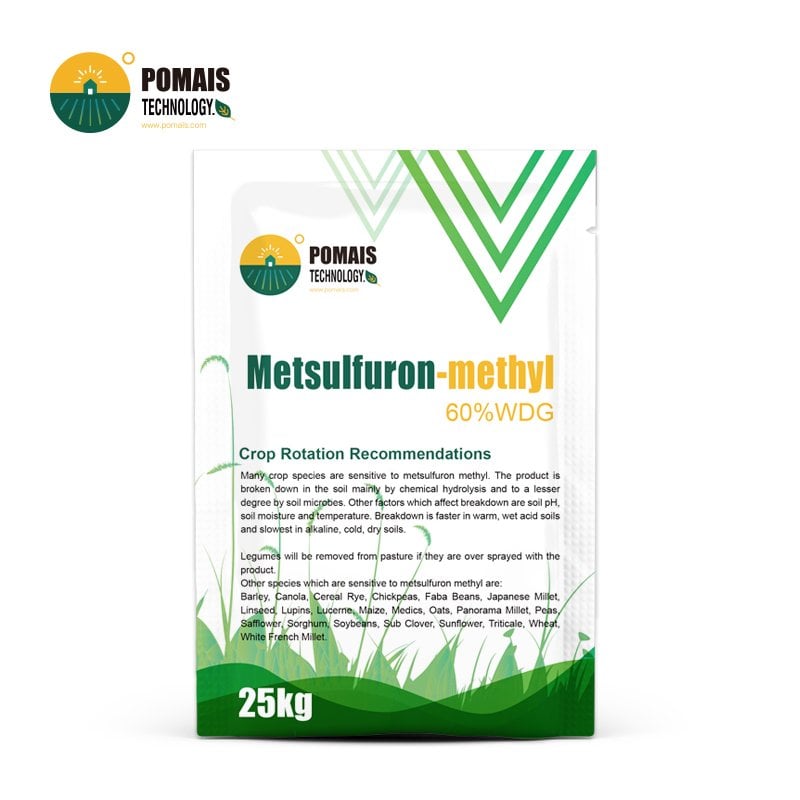Quinclorac Herbicide | Weed Killer Liquid or Granular
As a professional agrochemical supplier, we offer high-quality Quinclorac herbicide in both liquid and granular forms, tailored to your market needs. From customized formulations and packaging to registration support and global delivery, our team provides a complete solution for your weed control business. Whether you need Quinclorac 75% DF or 250g/L SC, we support OEM/ODM service, flexible labeling, and on-time exports to over 50 countries. Work with us to gain a reliable supply chain and competitive products for your local market.
- Designed for Professional Buyers & Bulk Orders
- This product is available for business purchase and large-scale distribution.
- We support custom packaging, labeling, and formulation to meet your market needs.
- Let’s build your brand together.

About Quinclorac Herbicide | Weed Killer Liquid or Granular
About Quinclorac Herbicide | Weed Killer Liquid or Granular
| Product Name | Quinclorac (Herbicide) |
| Active Ingredient | Quinclorac |
| CAS Number | 84087-01-4 |
| Molecular Formula | C10H5Cl2NO2 |
| Target Pests/Weeds | Annual and perennial broadleaf weeds, grasses such as barnyardgrass and crabgrass |
| Applicable Crops | Rice, turfgrass, wheat, barley, and corn |
| Dosage | 200-300 ml per acre |
| Mode of Action | Selective herbicide; absorbed by leaves and roots, interferes with cell growth and causes weed death |
| Tank Mix Compatibility | Compatible with other herbicides like 2,4-D, glyphosate, and insecticides |
| Common Formulations | Suspension Concentrate (SC) |
| Common Concentrations |
|
| Packaging Types | 500ml/bottle, 1L/bottle, 5L/container |
| Pre-Harvest Interval | 7-14 days |
| Company Strengths | POMAIS offers highly effective herbicides, supports global customization for OEM/ODM services, and provides tailored packaging solutions |
What Is Quinclorac Herbicide Used For?
Quinclorac is a selective herbicide known for its unique ability to control both grassy and broadleaf weeds, especially in crops and turf where other herbicides may fall short. It belongs to the synthetic auxin group and is widely used in rice, wheat, corn, and lawn care to combat stubborn invaders like crabgrass, torpedo grass, barnyard grass, and wild violets.
This herbicide works effectively as both a pre-emergent and post-emergent treatment, offering flexible weed control during different stages of plant growth. Unlike typical herbicides that focus only on either grassy or broadleaf species, Quinclorac delivers broad-spectrum control, making it a smart choice for integrated weed management.
Whether you are a crop protection distributor or a turf management specialist, Quinclorac provides:
- Reliable post-emergent crabgrass control, even after the weed has matured
- Preventive action when applied before weed germination (in compatible settings)
- Compatibility with tank mixes, especially with herbicides like 2,4-D and Atrazine for enhanced effect
In summary, Quinclorac is an ideal weed killer for markets looking for versatility, broad coverage, and strong results in both agricultural and turf environments.
Formulations and Active Ingredient Options
We offer Quinclorac in multiple high-performance formulations to meet diverse application needs, from large-scale crop protection to lawn care and turf management. All our products are developed with precision and undergo strict quality control to ensure consistent performance in various climatic and agricultural conditions.
Available Technical Formulations
- Quinclorac 75% DF (Dry Flowable / WDG)
A water-dispersible granular form designed for easy mixing, ideal for precision application in turf, rice, and cereals. Offers excellent storage stability and ease of transport. - Quinclorac 250 g/L SC (Suspension Concentrate)
A stable liquid formulation providing uniform coverage and fast absorption. Recommended for both pre-emergent and early post-emergent use in crop fields and managed landscapes. - Other Customizable Formulations (on request)
We can also produce tailored concentrations depending on your market registration or resistance management needs.
Popular Combination Products
We also offer ready-to-use blended formulations to expand spectrum and boost performance:
- Atrazine 25% + Quinclorac 15% SC – for maize and resistant weeds
- Anilofos 20% + Quinclorac 20% OD – optimized for rice paddies
- Propanil 25% + Quinclorac 15% OD – double-mode action for broadleaf and grass weeds
- Quinclorac 10% + Terbuthylazine 25% OD – dual-action residual control for industrial and turf areas
- Quinclorac + Fluroxypyr or Triclopyr – advanced solutions for turf and resistant broadleaf weeds
Custom Formulation and Concentration Options
Whether you are looking to register a new brand or expand your existing product line, we support:
- Custom concentration adjustments for Quinclorac-based products
- Formulation development with your own ratio requirements
- Stability testing and data support for different climates and crops
In essence, we help you build a competitive herbicide portfolio, with flexibility in formulation type, concentration level, and co-active ingredients—ready for your specific market.
Mode of Action and Weed Control Spectrum
Quinclorac works by disrupting the natural growth process of weeds through a synthetic auxin mode of action. After application, the herbicide is absorbed through both the roots and foliage. It then mimics plant hormones and interferes with cell wall expansion and auxin transport. This disruption leads to abnormal growth, followed by chlorosis, wilting, and eventual death of the target weeds.
What makes Quinclorac especially effective is its ability to control both grassy and broadleaf species. Many herbicides on the market only target one type, but Quinclorac offers dual-spectrum control. This allows users to simplify their spray programs while expanding the range of weed species managed with a single product.
Common Weeds Controlled by Quinclorac:
- Crabgrass (smooth and large varieties)
- Torpedo grass
- Barnyard grass
- Switchgrass
- Wild violets
- Dallisgrass (suppression)
- Clover (partial control in turf)
- False pimpernel and other sedges in rice fields
Its effectiveness is especially noticeable in post-emergence applications, where visible symptoms may appear within several days and full control typically occurs within one to two weeks, depending on weather and weed size. In pre-emergent uses, it suppresses early germination and seedling growth before weeds become established.
This combination of systemic activity and dual weed spectrum makes Quinclorac a valuable option for integrated weed management programs in both agriculture and turf.
Target Crops and Application Scenarios
Quinclorac herbicide is widely used across multiple agricultural and non-crop sectors due to its flexible weed control spectrum and selective safety for target plants. Whether applied in large-scale field crops or in professional turfgrass management, Quinclorac delivers reliable performance and long-lasting results.
Key Agricultural Applications
- Rice Fields
In rice cultivation, Quinclorac is highly effective against barnyard grass, sedges, and broadleaf invaders like false pimpernel. It is often used in flooded paddy systems, where it remains active in water for several days, ensuring prolonged control. - Wheat and Corn
In wheat and corn fields, Quinclorac targets problem grasses such as crabgrass, switchgrass, and torpedo grass. These weeds often compete for early nutrients and water, reducing yield potential. A timely post-emergent application helps maintain clean rows and efficient crop establishment.
Turfgrass and Lawns
- Residential and Commercial Lawns
Quinclorac is one of the most trusted herbicides for controlling mature crabgrass in lawns. It selectively removes grassy weeds while leaving desirable turf species such as bermudagrass and Kentucky bluegrass unharmed. - Golf Courses and Sports Fields
It is also used on fairways and athletic fields, where both appearance and function matter. The ability to control both grassy and broadleaf weeds with one product reduces application complexity and saves maintenance cost.
Industrial and Non-Crop Areas
- Roadside and Utility Corridors
Quinclorac is applied to manage invasive grasses in industrial zones, along fence lines, and around railways where vegetation control is essential for visibility and infrastructure protection. - Parks and Recreational Zones
Its selective nature and low re-entry interval make it suitable for areas with public access, where weed control must be effective but safe.
In summary, whether you are a crop grower, turf manager, or vegetation control contractor, Quinclorac provides consistent weed suppression across a wide range of environments.
Application Methods and Recommended Dosage
To achieve optimal weed control, it is important to apply Quinclorac herbicide correctly based on crop type, weed species, and growth stage. Our formulations are designed for both precision and ease of use in various farming systems and turf applications.
General Application Guidelines
- Application Timing
For best results, apply during the early post-emergence stage when weeds are young and actively growing. Quinclorac can also be used pre-emergence in suitable crops such as rice and turf. - Weed Growth Stage
Apply when grassy weeds are at the 1–3 tiller stage and broadleaf weeds are less than 5 centimeters tall. Avoid application on drought-stressed or mature weeds for maximum effectiveness. - Water Management in Rice
Maintain a standing water layer of 3–5 centimeters for 5–7 days after application to increase herbicide uptake through the roots.
Recommended Dosage by Crop
| Crop | Target Weeds | Recommended Dosage |
|---|---|---|
| Rice | Barnyard grass, false pimpernel | 15 grams per hectare |
| Wheat | Crabgrass, switchgrass, wild violets | 10–15 grams per hectare |
| Corn | Torpedo grass, barnyard grass | 12–18 grams per hectare |
| Lawns | Crabgrass, broadleaf weeds | 10–20 grams per hectare |
Always follow local label instructions and adjust dosage based on weed pressure and application equipment.
Mixing and Spraying Instructions
- Dilution Technique
Use the two-step mixing method. First, dilute the required amount of Quinclorac in half the spray water. Mix thoroughly, then add the remaining water to reach the desired spray volume. - Spray Equipment
Apply using flat fan nozzle sprayers with a pressure range of 40–50 psi. Ensure uniform coverage across the target area. Use clean water and avoid tank-mixing with alkaline substances unless compatibility has been tested. - Application Frequency
Apply once per crop cycle. Avoid overuse to prevent weed resistance and ensure sustainable management.
Proper application not only improves weed control but also reduces the risk of crop injury or environmental runoff. For specific use cases, we provide tailored application guides and training support for our distributors.
Advantages
Quinclorac herbicide stands out in the market due to its versatile performance, strong weed control spectrum, and compatibility across various agricultural and turf settings. Whether applied in rice fields, corn farms, or residential lawns, it offers users a dependable and long-lasting solution against stubborn weeds.
Broad-Spectrum Control
Quinclorac effectively targets both grassy and broadleaf weeds, including hard-to-kill species like crabgrass, torpedo grass, barnyard grass, and wild violets. This dual-action capability reduces the need for multiple herbicides and simplifies weed control programs.
Pre- and Post-Emergent Use
Few herbicides offer reliable performance before and after weed germination. Quinclorac delivers excellent control as a post-emergent for actively growing weeds, while also suppressing early-stage germination when applied pre-emergence under the right conditions.
Long Residual Activity
One application of Quinclorac can protect crops or turf for weeks, thanks to its strong residual presence in the soil or water layer. This minimizes the frequency of applications and reduces labor and material costs.
Selectivity and Crop Safety
Despite its potency, Quinclorac is selective and safe when used as directed. It does not harm major crops like rice, corn, or wheat, and is also safe on many turfgrass species. This selectivity gives users confidence in application without fear of crop injury.
Customizable Formulations and Packaging
We offer flexible options in concentration, co-formulation, and packaging. Whether you need a single active ingredient or a compound mix, we can provide a tailored solution that meets your market’s needs and regulations.
Environmentally Responsible
When applied correctly, Quinclorac has low leaching potential and limited impact on non-target organisms. It is compatible with modern environmental stewardship programs and safe for integrated weed management practices.
Quinclorac combines efficiency, reliability, and value—making it an ideal herbicide choice for distributors and professionals who demand consistent performance and market-ready versatility.
Flexible Packaging Solutions to Match Your Market Needs
We provide a wide range of packaging solutions for Quinclorac herbicide, designed to meet the requirements of both bulk importers and retail distributors. Whether you are sourcing for agricultural use or turf care, we can supply standardized or fully customized packages to match your brand strategy and local market preferences.
Bulk Packaging for Industrial and Agricultural Use
For large-scale field applications and repackaging purposes, we offer Quinclorac in the following bulk formats:
- Granular Form (DF or WDG)
- 25 kg bags (paper-plastic composite or kraft)
- 25 kg or 50 kg fiber drums with inner PE liner
- Liquid Form (SC)
- 200-liter HDPE drums
- 20-liter plastic drums
- 10-liter or 5-liter jerry cans for mid-scale users
These options are ideal for national distributors, co-packers, and those engaged in large-volume applications.
Small Packaging for Retail and Local Distribution
For markets requiring ready-to-sell retail packs, we offer a full range of small packaging solutions:
- Granular Form
- 1 kg, 500 g, 200 g, 100 g, and 50 g in aluminum foil or composite bags
- Available with tear notch, resealable zip, or flat-sealed finish
- Liquid Form
- 1-liter, 500 ml, 250 ml, 100 ml plastic bottles
- 5-liter HDPE jugs for professional turf or farm usage
All packaging can be supplied with custom printed labels, multilingual artwork, and anti-counterfeit features if required.
Labeling and Branding Support
To help you position your product effectively in competitive markets, we provide:
- Graphic design for label and box artwork
- Compliance with local language and regulation
- Brand name customization or white-label options
- Barcoding, QR codes, and tracking tags on request
Our packaging solutions combine durability, compliance, and visual appeal to enhance your brand’s presence on the shelf and in the field.
Safe to Handle, Easy to Store – Built for Practical Use
Quinclorac herbicide is formulated with both performance and user safety in mind. When used and stored as directed, it remains stable, effective, and compliant with agricultural safety standards. Whether you’re managing inventory in a warehouse or applying in the field, our product is engineered for convenience, safety, and regulatory confidence.
Storage Guidelines
- Temperature: Store in a cool, dry, and well-ventilated area. Avoid direct sunlight or extreme heat to maintain product integrity.
- Packaging Integrity: Always keep containers tightly sealed when not in use. Avoid physical damage during transport or handling.
- Shelf Life: Our formulations typically maintain full potency for 2 to 3 years under proper storage conditions.
Safety Instructions
- Personal Protection: During application, wear protective gloves, long-sleeved clothing, and a mask if spraying in enclosed or windy areas. Avoid contact with skin and eyes.
- Environmental Precautions: Do not apply near aquaculture ponds or water sources. Prevent runoff into irrigation canals, wells, or natural water bodies.
- Re-entry Period: Fields may typically be re-entered after the spray dries. In rice paddies, maintain water as advised to prevent off-target movement.
In Case of Emergency
- First Aid: If contact occurs, rinse affected skin or eyes with clean water for several minutes. If ingested, do not induce vomiting and seek medical help immediately.
- Spill Management: Use absorbent materials such as sand or soil to contain any spills. Dispose of contaminated material in accordance with local environmental regulations.
Our product is designed not just for effective weed control, but for ease of use and safe handling in real-world conditions. Safety data sheets (MSDS) and usage leaflets are available upon request for your team or downstream clients.
Frequently Asked Questions About Quinclorac Herbicide
Below are the most commonly asked questions from distributors, turf managers, and end users. This section will help your customers better understand how to use Quinclorac effectively and safely.
1. What is Quinclorac?
Quinclorac is a selective herbicide that controls both grassy and broadleaf weeds. It belongs to the synthetic auxin group and works by disrupting plant growth hormones.
2. What is Quinclorac Herbicide?
Quinclorac herbicide is a weed control solution available in liquid and granular forms. It is effective in rice, corn, wheat, and turfgrass, targeting tough weeds like crabgrass and torpedo grass.
3. How Does Quinclorac Work?
It is absorbed by both leaves and roots, then interferes with auxin transport in weeds. This causes abnormal growth, followed by leaf yellowing, wilting, and death.
4. What is Quinclorac Used For?
It is used to kill crabgrass, barnyard grass, wild violets, and other persistent weeds in agricultural fields and lawns.
5. Quinclorac Kills What Weeds?
It controls crabgrass, torpedo grass, barnyard grass, wild violets, clover, and some sedges. It may also suppress dallisgrass.
6. How to Apply Quinclorac?
Spray uniformly using flat fan nozzles at the recommended dosage. In rice fields, maintain shallow water after application for 5–7 days.
7. How to Mix Quinclorac?
Use a two-step mixing method. First, dilute in half the water, stir well, then top up with the remaining water before spraying.
8. How Much Quinclorac Per Gallon of Water?
Typically, 0.367 ounces (about 10.4 grams) per gallon is used, depending on weed pressure. Follow product label instructions for accuracy.
9. How Much Quinclorac Per Acre?
Apply 10–20 grams per hectare (or 4–8 grams per acre), depending on the crop and target weed species.
10. How Long After Quinclorac Can I Seed?
Wait at least 7 to 14 days before overseeding or planting new grass. This ensures residual activity does not affect germination.
11. Can You Mix Quinclorac and 2,4-D?
Yes, Quinclorac is compatible with 2,4-D. This combination is often used to enhance broadleaf and grassy weed control in turf applications.
12. How Long Does Quinclorac Take to Work?
Initial symptoms like yellowing may appear within 3–7 days. Full control is typically achieved in 10–14 days.
13. How Long Does It Take for Quinclorac to Kill Crabgrass?
It usually takes 7 to 14 days to kill crabgrass, depending on the growth stage and environmental conditions.
14. Will Quinclorac Kill Mature Crabgrass?
Yes, Quinclorac is one of the few herbicides effective on both young and mature crabgrass, even after tillering.
15. Is Quinclorac Safe?
Yes, when used as directed, it is safe for crops, turf, and handlers. Follow label safety precautions during application.
16. Is Quinclorac Safe for Bermuda Grass?
Yes, Quinclorac is generally safe for established Bermuda grass. Avoid applying to newly seeded turf.
17. Is Quinclorac Safe for Dogs?
Once dried, Quinclorac is considered safe for pets. Keep dogs away during and shortly after application.
18. Is Quinclorac Safe for Pets?
Yes, but avoid contact during application and allow treated areas to fully dry before pet exposure.
19. Does Quinclorac Kill Crabgrass?
Yes, it is widely used for post-emergent crabgrass control and provides effective results within two weeks.
20. Does Quinclorac Kill Clover?
It may suppress clover but is not a primary clover killer. For full control, it is often mixed with a broadleaf herbicide.
21. Does Quinclorac Kill Nutsedge?
Quinclorac has limited control on nutsedge. A dedicated sedge herbicide may be needed for full suppression.
22. Does Quinclorac Kill Dallisgrass?
It may suppress dallisgrass at early stages but is not fully effective alone. Tank mixing is recommended for better results.
23. Does Quinclorac Kill Grass?
It selectively kills weedy grasses like crabgrass and torpedo grass, without harming desirable crops or turfgrass when used correctly.
24. Will Quinclorac Kill Wild Violets?
Yes, Quinclorac provides good control of wild violets, especially when applied early in their growth cycle.
| Product Name | Quinclorac (Herbicide) |
| Active Ingredient | Quinclorac |
| CAS Number | 84087-01-4 |
| Molecular Formula | C10H5Cl2NO2 |
| Target Pests/Weeds | Annual and perennial broadleaf weeds, grasses such as barnyardgrass and crabgrass |
| Applicable Crops | Rice, turfgrass, wheat, barley, and corn |
| Dosage | 200-300 ml per acre |
| Mode of Action | Selective herbicide; absorbed by leaves and roots, interferes with cell growth and causes weed death |
| Tank Mix Compatibility | Compatible with other herbicides like 2,4-D, glyphosate, and insecticides |
| Common Formulations | Suspension Concentrate (SC) |
| Common Concentrations |
|
| Packaging Types | 500ml/bottle, 1L/bottle, 5L/container |
| Pre-Harvest Interval | 7-14 days |
| Company Strengths | POMAIS offers highly effective herbicides, supports global customization for OEM/ODM services, and provides tailored packaging solutions |
What Is Quinclorac Herbicide Used For?
Quinclorac is a selective herbicide known for its unique ability to control both grassy and broadleaf weeds, especially in crops and turf where other herbicides may fall short. It belongs to the synthetic auxin group and is widely used in rice, wheat, corn, and lawn care to combat stubborn invaders like crabgrass, torpedo grass, barnyard grass, and wild violets.
This herbicide works effectively as both a pre-emergent and post-emergent treatment, offering flexible weed control during different stages of plant growth. Unlike typical herbicides that focus only on either grassy or broadleaf species, Quinclorac delivers broad-spectrum control, making it a smart choice for integrated weed management.
Whether you are a crop protection distributor or a turf management specialist, Quinclorac provides:
- Reliable post-emergent crabgrass control, even after the weed has matured
- Preventive action when applied before weed germination (in compatible settings)
- Compatibility with tank mixes, especially with herbicides like 2,4-D and Atrazine for enhanced effect
In summary, Quinclorac is an ideal weed killer for markets looking for versatility, broad coverage, and strong results in both agricultural and turf environments.
Formulations and Active Ingredient Options
We offer Quinclorac in multiple high-performance formulations to meet diverse application needs, from large-scale crop protection to lawn care and turf management. All our products are developed with precision and undergo strict quality control to ensure consistent performance in various climatic and agricultural conditions.
Available Technical Formulations
- Quinclorac 75% DF (Dry Flowable / WDG)
A water-dispersible granular form designed for easy mixing, ideal for precision application in turf, rice, and cereals. Offers excellent storage stability and ease of transport. - Quinclorac 250 g/L SC (Suspension Concentrate)
A stable liquid formulation providing uniform coverage and fast absorption. Recommended for both pre-emergent and early post-emergent use in crop fields and managed landscapes. - Other Customizable Formulations (on request)
We can also produce tailored concentrations depending on your market registration or resistance management needs.
Popular Combination Products
We also offer ready-to-use blended formulations to expand spectrum and boost performance:
- Atrazine 25% + Quinclorac 15% SC – for maize and resistant weeds
- Anilofos 20% + Quinclorac 20% OD – optimized for rice paddies
- Propanil 25% + Quinclorac 15% OD – double-mode action for broadleaf and grass weeds
- Quinclorac 10% + Terbuthylazine 25% OD – dual-action residual control for industrial and turf areas
- Quinclorac + Fluroxypyr or Triclopyr – advanced solutions for turf and resistant broadleaf weeds
Custom Formulation and Concentration Options
Whether you are looking to register a new brand or expand your existing product line, we support:
- Custom concentration adjustments for Quinclorac-based products
- Formulation development with your own ratio requirements
- Stability testing and data support for different climates and crops
In essence, we help you build a competitive herbicide portfolio, with flexibility in formulation type, concentration level, and co-active ingredients—ready for your specific market.
Mode of Action and Weed Control Spectrum
Quinclorac works by disrupting the natural growth process of weeds through a synthetic auxin mode of action. After application, the herbicide is absorbed through both the roots and foliage. It then mimics plant hormones and interferes with cell wall expansion and auxin transport. This disruption leads to abnormal growth, followed by chlorosis, wilting, and eventual death of the target weeds.
What makes Quinclorac especially effective is its ability to control both grassy and broadleaf species. Many herbicides on the market only target one type, but Quinclorac offers dual-spectrum control. This allows users to simplify their spray programs while expanding the range of weed species managed with a single product.
Common Weeds Controlled by Quinclorac:
- Crabgrass (smooth and large varieties)
- Torpedo grass
- Barnyard grass
- Switchgrass
- Wild violets
- Dallisgrass (suppression)
- Clover (partial control in turf)
- False pimpernel and other sedges in rice fields
Its effectiveness is especially noticeable in post-emergence applications, where visible symptoms may appear within several days and full control typically occurs within one to two weeks, depending on weather and weed size. In pre-emergent uses, it suppresses early germination and seedling growth before weeds become established.
This combination of systemic activity and dual weed spectrum makes Quinclorac a valuable option for integrated weed management programs in both agriculture and turf.
Target Crops and Application Scenarios
Quinclorac herbicide is widely used across multiple agricultural and non-crop sectors due to its flexible weed control spectrum and selective safety for target plants. Whether applied in large-scale field crops or in professional turfgrass management, Quinclorac delivers reliable performance and long-lasting results.
Key Agricultural Applications
- Rice Fields
In rice cultivation, Quinclorac is highly effective against barnyard grass, sedges, and broadleaf invaders like false pimpernel. It is often used in flooded paddy systems, where it remains active in water for several days, ensuring prolonged control. - Wheat and Corn
In wheat and corn fields, Quinclorac targets problem grasses such as crabgrass, switchgrass, and torpedo grass. These weeds often compete for early nutrients and water, reducing yield potential. A timely post-emergent application helps maintain clean rows and efficient crop establishment.
Turfgrass and Lawns
- Residential and Commercial Lawns
Quinclorac is one of the most trusted herbicides for controlling mature crabgrass in lawns. It selectively removes grassy weeds while leaving desirable turf species such as bermudagrass and Kentucky bluegrass unharmed. - Golf Courses and Sports Fields
It is also used on fairways and athletic fields, where both appearance and function matter. The ability to control both grassy and broadleaf weeds with one product reduces application complexity and saves maintenance cost.
Industrial and Non-Crop Areas
- Roadside and Utility Corridors
Quinclorac is applied to manage invasive grasses in industrial zones, along fence lines, and around railways where vegetation control is essential for visibility and infrastructure protection. - Parks and Recreational Zones
Its selective nature and low re-entry interval make it suitable for areas with public access, where weed control must be effective but safe.
In summary, whether you are a crop grower, turf manager, or vegetation control contractor, Quinclorac provides consistent weed suppression across a wide range of environments.
Application Methods and Recommended Dosage
To achieve optimal weed control, it is important to apply Quinclorac herbicide correctly based on crop type, weed species, and growth stage. Our formulations are designed for both precision and ease of use in various farming systems and turf applications.
General Application Guidelines
- Application Timing
For best results, apply during the early post-emergence stage when weeds are young and actively growing. Quinclorac can also be used pre-emergence in suitable crops such as rice and turf. - Weed Growth Stage
Apply when grassy weeds are at the 1–3 tiller stage and broadleaf weeds are less than 5 centimeters tall. Avoid application on drought-stressed or mature weeds for maximum effectiveness. - Water Management in Rice
Maintain a standing water layer of 3–5 centimeters for 5–7 days after application to increase herbicide uptake through the roots.
Recommended Dosage by Crop
| Crop | Target Weeds | Recommended Dosage |
|---|---|---|
| Rice | Barnyard grass, false pimpernel | 15 grams per hectare |
| Wheat | Crabgrass, switchgrass, wild violets | 10–15 grams per hectare |
| Corn | Torpedo grass, barnyard grass | 12–18 grams per hectare |
| Lawns | Crabgrass, broadleaf weeds | 10–20 grams per hectare |
Always follow local label instructions and adjust dosage based on weed pressure and application equipment.
Mixing and Spraying Instructions
- Dilution Technique
Use the two-step mixing method. First, dilute the required amount of Quinclorac in half the spray water. Mix thoroughly, then add the remaining water to reach the desired spray volume. - Spray Equipment
Apply using flat fan nozzle sprayers with a pressure range of 40–50 psi. Ensure uniform coverage across the target area. Use clean water and avoid tank-mixing with alkaline substances unless compatibility has been tested. - Application Frequency
Apply once per crop cycle. Avoid overuse to prevent weed resistance and ensure sustainable management.
Proper application not only improves weed control but also reduces the risk of crop injury or environmental runoff. For specific use cases, we provide tailored application guides and training support for our distributors.
Advantages
Quinclorac herbicide stands out in the market due to its versatile performance, strong weed control spectrum, and compatibility across various agricultural and turf settings. Whether applied in rice fields, corn farms, or residential lawns, it offers users a dependable and long-lasting solution against stubborn weeds.
Broad-Spectrum Control
Quinclorac effectively targets both grassy and broadleaf weeds, including hard-to-kill species like crabgrass, torpedo grass, barnyard grass, and wild violets. This dual-action capability reduces the need for multiple herbicides and simplifies weed control programs.
Pre- and Post-Emergent Use
Few herbicides offer reliable performance before and after weed germination. Quinclorac delivers excellent control as a post-emergent for actively growing weeds, while also suppressing early-stage germination when applied pre-emergence under the right conditions.
Long Residual Activity
One application of Quinclorac can protect crops or turf for weeks, thanks to its strong residual presence in the soil or water layer. This minimizes the frequency of applications and reduces labor and material costs.
Selectivity and Crop Safety
Despite its potency, Quinclorac is selective and safe when used as directed. It does not harm major crops like rice, corn, or wheat, and is also safe on many turfgrass species. This selectivity gives users confidence in application without fear of crop injury.
Customizable Formulations and Packaging
We offer flexible options in concentration, co-formulation, and packaging. Whether you need a single active ingredient or a compound mix, we can provide a tailored solution that meets your market’s needs and regulations.
Environmentally Responsible
When applied correctly, Quinclorac has low leaching potential and limited impact on non-target organisms. It is compatible with modern environmental stewardship programs and safe for integrated weed management practices.
Quinclorac combines efficiency, reliability, and value—making it an ideal herbicide choice for distributors and professionals who demand consistent performance and market-ready versatility.
Flexible Packaging Solutions to Match Your Market Needs
We provide a wide range of packaging solutions for Quinclorac herbicide, designed to meet the requirements of both bulk importers and retail distributors. Whether you are sourcing for agricultural use or turf care, we can supply standardized or fully customized packages to match your brand strategy and local market preferences.
Bulk Packaging for Industrial and Agricultural Use
For large-scale field applications and repackaging purposes, we offer Quinclorac in the following bulk formats:
- Granular Form (DF or WDG)
- 25 kg bags (paper-plastic composite or kraft)
- 25 kg or 50 kg fiber drums with inner PE liner
- Liquid Form (SC)
- 200-liter HDPE drums
- 20-liter plastic drums
- 10-liter or 5-liter jerry cans for mid-scale users
These options are ideal for national distributors, co-packers, and those engaged in large-volume applications.
Small Packaging for Retail and Local Distribution
For markets requiring ready-to-sell retail packs, we offer a full range of small packaging solutions:
- Granular Form
- 1 kg, 500 g, 200 g, 100 g, and 50 g in aluminum foil or composite bags
- Available with tear notch, resealable zip, or flat-sealed finish
- Liquid Form
- 1-liter, 500 ml, 250 ml, 100 ml plastic bottles
- 5-liter HDPE jugs for professional turf or farm usage
All packaging can be supplied with custom printed labels, multilingual artwork, and anti-counterfeit features if required.
Labeling and Branding Support
To help you position your product effectively in competitive markets, we provide:
- Graphic design for label and box artwork
- Compliance with local language and regulation
- Brand name customization or white-label options
- Barcoding, QR codes, and tracking tags on request
Our packaging solutions combine durability, compliance, and visual appeal to enhance your brand’s presence on the shelf and in the field.
Safe to Handle, Easy to Store – Built for Practical Use
Quinclorac herbicide is formulated with both performance and user safety in mind. When used and stored as directed, it remains stable, effective, and compliant with agricultural safety standards. Whether you’re managing inventory in a warehouse or applying in the field, our product is engineered for convenience, safety, and regulatory confidence.
Storage Guidelines
- Temperature: Store in a cool, dry, and well-ventilated area. Avoid direct sunlight or extreme heat to maintain product integrity.
- Packaging Integrity: Always keep containers tightly sealed when not in use. Avoid physical damage during transport or handling.
- Shelf Life: Our formulations typically maintain full potency for 2 to 3 years under proper storage conditions.
Safety Instructions
- Personal Protection: During application, wear protective gloves, long-sleeved clothing, and a mask if spraying in enclosed or windy areas. Avoid contact with skin and eyes.
- Environmental Precautions: Do not apply near aquaculture ponds or water sources. Prevent runoff into irrigation canals, wells, or natural water bodies.
- Re-entry Period: Fields may typically be re-entered after the spray dries. In rice paddies, maintain water as advised to prevent off-target movement.
In Case of Emergency
- First Aid: If contact occurs, rinse affected skin or eyes with clean water for several minutes. If ingested, do not induce vomiting and seek medical help immediately.
- Spill Management: Use absorbent materials such as sand or soil to contain any spills. Dispose of contaminated material in accordance with local environmental regulations.
Our product is designed not just for effective weed control, but for ease of use and safe handling in real-world conditions. Safety data sheets (MSDS) and usage leaflets are available upon request for your team or downstream clients.
Frequently Asked Questions About Quinclorac Herbicide
Below are the most commonly asked questions from distributors, turf managers, and end users. This section will help your customers better understand how to use Quinclorac effectively and safely.
1. What is Quinclorac?
Quinclorac is a selective herbicide that controls both grassy and broadleaf weeds. It belongs to the synthetic auxin group and works by disrupting plant growth hormones.
2. What is Quinclorac Herbicide?
Quinclorac herbicide is a weed control solution available in liquid and granular forms. It is effective in rice, corn, wheat, and turfgrass, targeting tough weeds like crabgrass and torpedo grass.
3. How Does Quinclorac Work?
It is absorbed by both leaves and roots, then interferes with auxin transport in weeds. This causes abnormal growth, followed by leaf yellowing, wilting, and death.
4. What is Quinclorac Used For?
It is used to kill crabgrass, barnyard grass, wild violets, and other persistent weeds in agricultural fields and lawns.
5. Quinclorac Kills What Weeds?
It controls crabgrass, torpedo grass, barnyard grass, wild violets, clover, and some sedges. It may also suppress dallisgrass.
6. How to Apply Quinclorac?
Spray uniformly using flat fan nozzles at the recommended dosage. In rice fields, maintain shallow water after application for 5–7 days.
7. How to Mix Quinclorac?
Use a two-step mixing method. First, dilute in half the water, stir well, then top up with the remaining water before spraying.
8. How Much Quinclorac Per Gallon of Water?
Typically, 0.367 ounces (about 10.4 grams) per gallon is used, depending on weed pressure. Follow product label instructions for accuracy.
9. How Much Quinclorac Per Acre?
Apply 10–20 grams per hectare (or 4–8 grams per acre), depending on the crop and target weed species.
10. How Long After Quinclorac Can I Seed?
Wait at least 7 to 14 days before overseeding or planting new grass. This ensures residual activity does not affect germination.
11. Can You Mix Quinclorac and 2,4-D?
Yes, Quinclorac is compatible with 2,4-D. This combination is often used to enhance broadleaf and grassy weed control in turf applications.
12. How Long Does Quinclorac Take to Work?
Initial symptoms like yellowing may appear within 3–7 days. Full control is typically achieved in 10–14 days.
13. How Long Does It Take for Quinclorac to Kill Crabgrass?
It usually takes 7 to 14 days to kill crabgrass, depending on the growth stage and environmental conditions.
14. Will Quinclorac Kill Mature Crabgrass?
Yes, Quinclorac is one of the few herbicides effective on both young and mature crabgrass, even after tillering.
15. Is Quinclorac Safe?
Yes, when used as directed, it is safe for crops, turf, and handlers. Follow label safety precautions during application.
16. Is Quinclorac Safe for Bermuda Grass?
Yes, Quinclorac is generally safe for established Bermuda grass. Avoid applying to newly seeded turf.
17. Is Quinclorac Safe for Dogs?
Once dried, Quinclorac is considered safe for pets. Keep dogs away during and shortly after application.
18. Is Quinclorac Safe for Pets?
Yes, but avoid contact during application and allow treated areas to fully dry before pet exposure.
19. Does Quinclorac Kill Crabgrass?
Yes, it is widely used for post-emergent crabgrass control and provides effective results within two weeks.
20. Does Quinclorac Kill Clover?
It may suppress clover but is not a primary clover killer. For full control, it is often mixed with a broadleaf herbicide.
21. Does Quinclorac Kill Nutsedge?
Quinclorac has limited control on nutsedge. A dedicated sedge herbicide may be needed for full suppression.
22. Does Quinclorac Kill Dallisgrass?
It may suppress dallisgrass at early stages but is not fully effective alone. Tank mixing is recommended for better results.
23. Does Quinclorac Kill Grass?
It selectively kills weedy grasses like crabgrass and torpedo grass, without harming desirable crops or turfgrass when used correctly.
24. Will Quinclorac Kill Wild Violets?
Yes, Quinclorac provides good control of wild violets, especially when applied early in their growth cycle.
Related Products
Latest News

